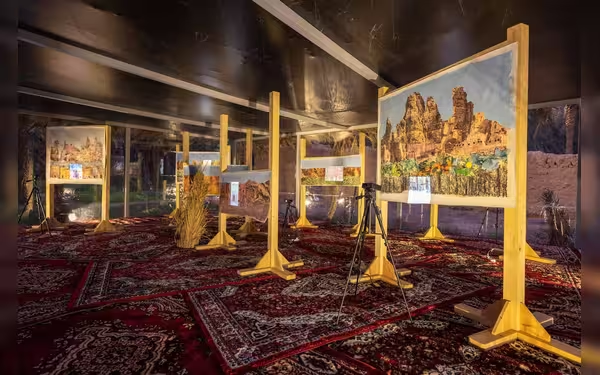Saturday, November 16, 2024 08:51 PM
Daniah Alsaleh: Saudi Artist Embracing Tradition and Change
- Daniah Alsaleh explores memory and media in her art.
- Her work blends traditional techniques with modern technology.
- She emphasizes the importance of adaptability in art.
 Image Credits: arabnewspk
Image Credits: arabnewspkDaniah Alsaleh, a Saudi artist, merges tradition with modernity, exploring memory and media through innovative art.
Daniah Alsaleh, a prominent Saudi artist, has made significant strides in the world of visual arts, focusing on themes of social conditioning and memory. Her journey into the art world began in Riyadh, where she was born and raised. Despite her early interest in art, it was not until she moved to Jeddah that she truly immersed herself in the field. Studying under the late Safeya Binzagr for several years, Alsaleh honed her skills in drawing, painting, and color theory. This foundational training paved the way for her to explore more complex artistic expressions, particularly Islamic geometry.
In 2012, Alsaleh showcased her work in a group exhibition, marking her entry into the art scene. By 2013, she had joined Athr Gallery, which signified a turning point in her career as she decided to pursue art full-time. Her move to London in 2014 was another pivotal moment, as she applied for a Master’s in Fine Art at Goldsmiths. Although she did not gain admission to her desired program, she was offered a place in Computational Arts, which transformed her artistic practice. This program introduced her to the world of technology, allowing her to incorporate machine learning into her work.
Alsaleh emphasizes that she is not merely an "AI artist" but a visual artist who utilizes machine learning as one of her many tools. Her work often explores the relationship between memory and media, questioning how social conditioning shapes our perceptions and experiences. She is particularly interested in the everyday aspects of life that we often take for granted, such as the influence of media on our memories.
One of her notable works from 2017 features five panels of hand-drawn Islamic patterns, interrupted by a random brushstroke. This piece serves as a commentary on the tension between tradition and change, highlighting the importance of embracing new ideas while celebrating historical practices. Another significant installation, which won the Ithra Art Prize in 2019, combines visuals inspired by German new-media artist Manfred Mohr with sound elements that create a unique auditory experience. This work reflects on communication and the complexities of expression in a modern context.
In her installation for the Diriyah Biennale, Alsaleh delves into the concept of collective versus individual memory. She uses machine-generated faces to represent the changing landscape of Saudi Arabia, illustrating how development can obscure personal histories. Visitors to the installation often find themselves connecting with the faces, as they evoke familiar features from their own lives, despite being entirely fictional creations.
Alsaleh's work is a testament to the evolving nature of art in the contemporary world. By blending traditional techniques with modern technology, she not only preserves cultural heritage but also invites audiences to reflect on their own memories and experiences. As she continues to explore the intersections of art, memory, and technology, her journey serves as an inspiration for aspiring artists and a reminder of the importance of adaptability in a rapidly changing world.













